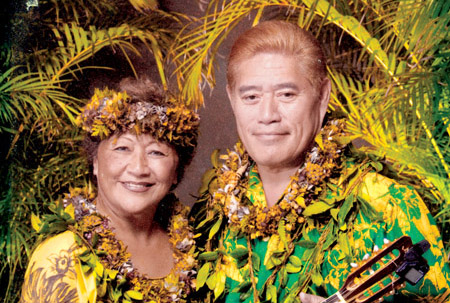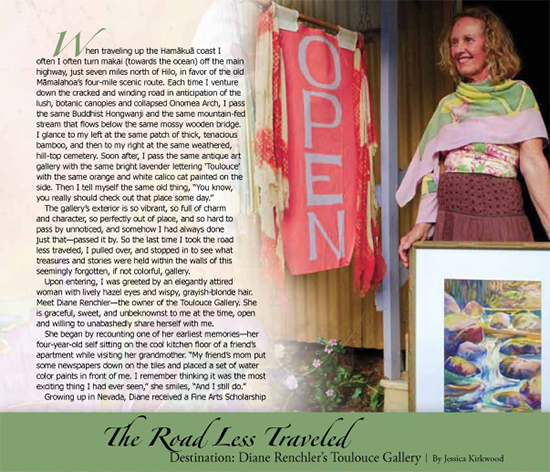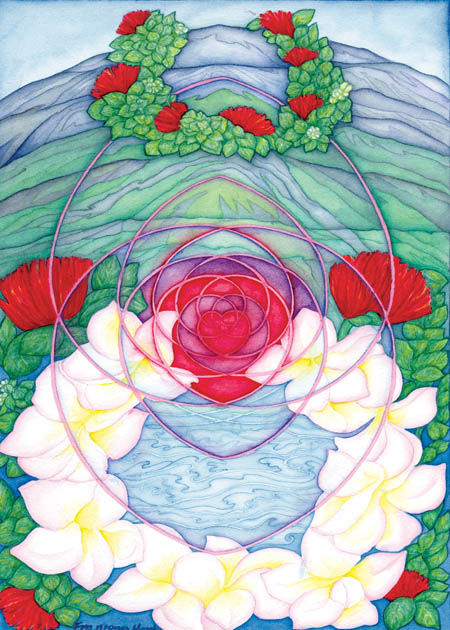
One Woman’s Tree of Life Bears Beautiful Art: Caren Loebel-Fried Retells the Legends of Hawaii in Block Prints and Books

By Marya Mann, Ph.D.
Caren Loebel-Fried is in love with nature, art, mythology, dreams, and the study of cultures that live “at one” with nature. All these loves blend together eloquently in her creations.
One of Hawaii’s most beloved myths, Lauka’ie’ie (pronounced lowka-eeyai-eeyai) tells the tale of her magical birth from a cloud of red mist. A great ‘ōhi’a tree emerges from the mist where the wide mouth of the river meets the ocean at Waipi’o Valley, and the goddess Hina and god Kū appear, holding a new baby—a gift for a formerly childless couple, Lauka’ie’ie’s parents.
In the rest of the story, there’s a singing snail, a Chief of the Wind who operates a kind of cosmic taxicab, and a thousand red ‘i’iwi birds who help the divinely born Lauka’ie’ie find the man of her dreams.
If this tale sounds fantastic, know you’ve entered the ancient Hawaiian world of legend where water, scented breezes, lehua blossoms, and even the crickets peeping underfoot all chant out universal truths in rhythm with spirits. All are metaphors to help people make sense of life.
This legend becomes alive in vibrant color and block-print art with its retelling in Loebel-Fried’s book, Hawaiian Legends of Dreams.
Children’s tales for walking Hawaii’s rainforest paths? Yes, but more, much more. Myths are not falsehoods. They are facts of the mind, stories told by and from the soul of nature to restore the human spirit.
The tale of Loebel-Fried’s own journey to find ancient Hawaiian myths, carve their unifying visions out of linoleum blocks, print them, color them, re-write them, and bear them into the limelight might be entitled, “My Tree of Life.”
Magical roots would be found in her first teacher, Nature, in the glades and woodlands of New Jersey, where the artist walked as a child to behold the bark, limbs, and moist leaves in the forests near her home.
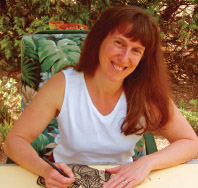
The trunk is her mother, Sheilah Loebel, who taught block printing in the family basement: “I would hide under the table and listen,” she says. “Mom was always making things, and encouraging me to make things. She taught me how to live a life of art and expression.”
The bark of Caren’s tree of life, connecting her inner heart to its environs, would be her discovery of early Hawaiian block printing.
“It was an important connection for me with Hawai’i and my own background,” she says. “’Ohe kapala—block printing with carved bamboo stamps on kapa fabric—was women’s work in early Hawaiian life.”
Block printing was passed down to her by her own mother in “a very kumu-like process of teaching by example, which is also a Hawaiian practice,” she says.
Loebel-Fried’s carving and study branched out, and she finally moved to Hawaii in the early 1990s with a dream of learning everything she could about Hawaiian mythology. It rose in her like a sap, spending itself in long hours among the dusty archives of Honolulu’s Bishop Museum Library, where she placed her carver’s hands on historic manuscripts carrying legends which told of the emotional fire of Hawaii’s ancient culture.
While research thrilled her, it wasn’t enough. She wanted more “real-life role models” to help her with getting the “feel” right, someone Hawaiian willing to teach her and trust her sincere wish to learn.
“My own experience when I came to Hawai’i was to feel the stories alive in the nature around me, in the birds, the plants, the wind, the volcano. I felt such a personal connection, but I wanted to know if I was approaching it in my work correctly, in a ‘Hawaiian’ way.” So when she heard Auntie Nona Desha Beamer, the beloved kumu hula, cultural teacher and storyteller, speak, she wrote her a letter and was invited to call.
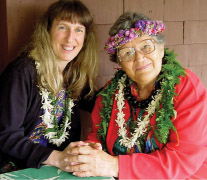
“We hit it off! She was so patient, gracious, and loving to me right from the start,” she says. “She lived in Hilo, and I was in Volcano, so we would go to the market together, have lunch, hang out at her place or mine and talk story. She was so generous with her time. She became my mentor.”
Auntie Nona reviewed the manuscript and wrote in her foreword to Loebel-Fried’s first book, Hawaiian Legends of the Guardian Spirits, “The strength of Caren’s retelling comes from a very honest wellspring of love for her work on behalf of Hawai’i and its people.” The book went on to win an award, Ka Palapala Po‘okela in 2003. It was followed by the companion book, Hawaiian Legends of Dreams, in 2005.
The two began to collaborate with original work—Nona telling stories and Caren creating the accompanying art—in two new books for children, Pua Polu and Naupaka. Together their voices became more powerful.
With Auntie Nona’s loving encouragement, Caren, second generation woodcarver, artist, and author, has applied eloquence and precision — as well as her painstaking research at the Bishop Museum Archives — to bring a total of five magnificent books to life, which are nothing less than the wisdom of nature emerging directly from sky, fire, wood, and soul. Her illustrations, in color and black-and-white are also available for purchase in prints or cards.
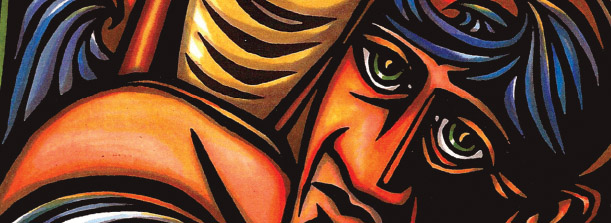
As the artist finished the illustrations to their last collaboration, Naupaka (Nona Beamer passed away last year), she became more conscious of how the images and stories, through the blocks, were giving nature a voice. Her relationship with Nona, her cultural studies kumu, also opened the door for another of nature’s arts, the hula.
From telling the old stories through block printing and writing, she is now retelling the ancient stories through her body. “I’m a beginner,” says Caren, who started studying Hawaiian dance two years ago with Kumu Hula June Kaili Tanoue, but the hula is deepening her original visceral connection with the storied landscape.
“Nature is so powerful and legends speak of that. I can think about a legend, feel it, be inspired by it, and learn from it, but it’s unusual to experience myth through the dance, in hula, where my body becomes the expression.
“Movement has changed the way I do art and understand the legends,” she says, which is one reason she’s working on a new series of prints for an exhibit at Volcano Art Center called “Legends of the Hula,” to show the dance and stories behind it.
If her books are the leaves and hula is the flowering of this artist’s magical tree of life, then significant seeds for spreading these ancient Hawaiian stories and life lessons across the ‘aina may come from her commitment to teaching. Teachers or groups who would like to enjoy her talk story, block printing classes, or PowerPoint presentations of the book, Naupaka, can reach her at www.carenloebelfried.com.
“I’m a lucky girl,” she says. “I’m living my dream.” Lauka’ie’ie couldn’t have said it better. ❖
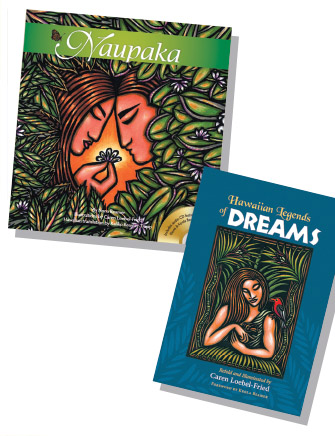 Hawaiian Legends of Dreams explores the significance of dreams in Hawaiian culture, telling and illustrating nine poignant tales, including “Lauka’ie’ie.”
Hawaiian Legends of Dreams explores the significance of dreams in Hawaiian culture, telling and illustrating nine poignant tales, including “Lauka’ie’ie.”
Naupaka, winner of two 2009 Ka Palapala Po`okela Book Awards. The Honolulu Advertiser described it as, “combining good storytelling, beguiling illustrations and a companion CD read by the late, beloved Nona Beamer, set to the gentle background music of her son Keola Beamer.” ‘Naupaka’ is an ancient Hawaiian tale of a princess who falls in love with a commoner. The story is told in English with the Hawaiian translation by Kaliko Beamer-Trapp.
